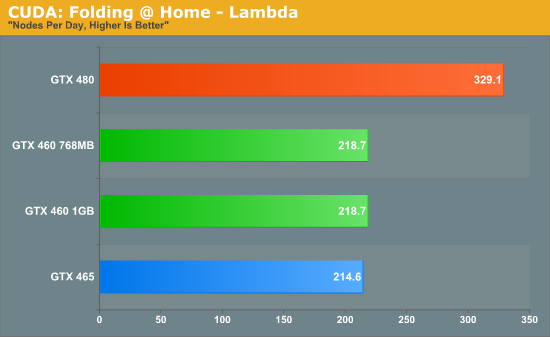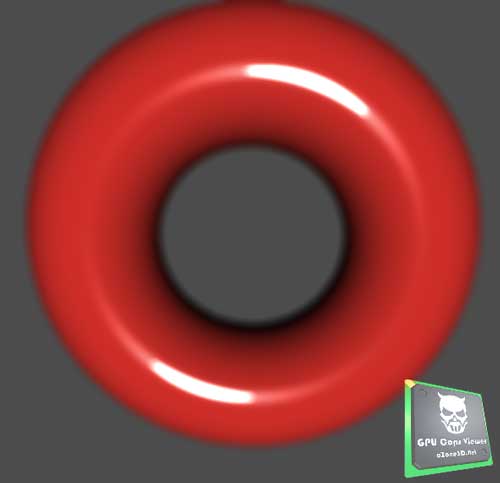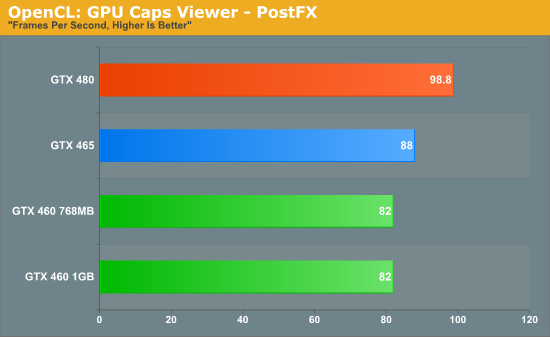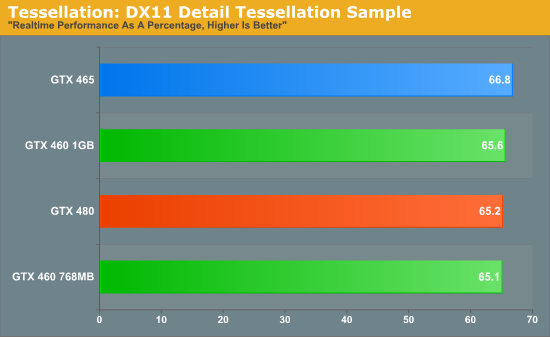NVIDIA’s GeForce GTX 460: The $200 King
by Ryan Smith on July 11, 2010 11:54 PM EST- Posted in
- GPUs
- GeForce GTX 400
- GeForce GTX 460
- NVIDIA
Compute & Tessellation Performance
With our earlier discussion on the GF104’s revised architecture in mind, along with our gaming benchmarks we have also run a selection of compute and tessellation benchmarks specifically to look at the architecture. Due to the fact that NVIDIA added an additional block of CUDA cores to an SM without adding another warp scheduler, the resulting superscalar design requires that the card extract ILP from the warps in order to simultaneously utilize all 3 blocks of CUDA cores.
As a result the range of best case to worst case scenarios is wider on GF104 than it is GF100: while GF100 could virtually always keep 2 warps going and reach peak utilization, GF104 can only reach peak utilization when at least 1 of the warps has an ILP-safe instruction waiting to go, otherwise the 3rd block of CUDA cores is effectively stalled and a GTX 460 performs more like a 224 CUDA core part. Conversely with a total of 4 dispatch units GF104 is capable of exceeding GF100’s efficiency by utilizing 4 of 7 execution blocks in an SM instead of 2 of 6.
Or in other words, GF104 has the possibility of being more or less efficient than GF100.
For our testing we’re utilizing a GTX 480, a GTX 465, and both versions of the GTX 460, the latter in particular to see if the lack of L2 cache or memory bandwidth will have a significant impact on compute performance. Something to keep in mind is that with its higher clockspeed, the GTX 460 has more compute performance on paper than the GTX 465 – 907GFLOPs for the GTX 460, versus 855GFLOPs for the GTX 465. As such the GTX 460 has the potential to win, but only when it can extract enough ILP to keep the 3rd block of CUDA cores working. Otherwise the worst case scenario – every math instruction is dependent – is 605GFLOPs for the GTX 460. Meanwhile the GTX 480 is capable of 1344GFLOPs, which means the GTX 465 and GTX 460 are 63% and 45%-67% as fast as it on paper respectively.

We’ll start with Stanford’s Folding@Home client. Here we’re using the same benchmark version of the client as from our GTX 480 article, running the Lambda work-unit. In this case we almost have a tie between the GTX 460 and the GTX 465, with the two differing by only a few nodes per day. The GTX 465 reaches 65% of the performance of the GTX 480 here, which is actually beyond the theoretical performance difference. In this case it’s likely that the GTX 480 may be held back elsewhere, allowing slower cards to shorten the gap by some degree.
With that in mind the GTX 460 cards achieve 66% of the performance of the GTX 480 here, giving them a slight edge over the GTX 465. Because we’ve seen the GTX 465 pull off better than perfect scaling here it’s very unlikely that the GTX 460 is actually achieving a perfect ILP scenario here, but clearly it must be close. Folding@Home is clearly not L2 cache or memory bandwidth dependent either, as the 768MB version of the GTX 460 does no worse than its 1GB counterpart.

Next up on our list of compute benchmarks is Badaboom, the CUDA-based video encoder. Here we’re measuring the average framerate for the encode of a 2 minute 1080i video cap. Right off the bat we’re seeing dramatically different results than we saw with Folding@Home, with the GTX 460 cards falling well behind the GTX 465. It’s immediately clear here that Badaboom is presenting a sub-optimal scenario for the GTX 460 where the GPU cannot effectively extract much ILP from the program’s warps. At 56% the speed of a GTX 480, this is worse off than what we saw with Folding@Home but is also right in the middle of our best/worst case scenarios – if anything Badaboom is probably very close to average.
Meanwhile this is another program with the lack of memory bandwidth and L2 cache is not affecting the 768MB card in the slightest, as it returns the same 35fps rate as the 1GB card.


Our third and final compute benchmark is the PostFX OpenCL benchmark from GPU Caps Viewer. The PostFX benchmark clearly isn’t solely compute limited on the GTX 400 series, giving us a fairly narrow range of results that are otherwise consistent with the Badaboom. At 82fps, this puts the GTX 460 below the GTX 465 by around 7%, once again showcasing that the superscalar GTX 460 has more trouble achieving its peak efficiency than the more straightforward GTX 465.


Our final benchmark is a quick look at tessellation. As GF104 packed more CUDA cores in to a SM, the GPU has more than half the compute capabilities of GF100 but only a straight 50% the geometry capabilities. Specifically, the GTX 460 has 45% of the geometry capabilities of the GTX 480 after taking in to account the number of active SMs and the clockspeed difference.
With the DirectX 11 Detail Tessellation sample program, we’re primarily looking at whether we can throw a high enough tessellation load at the GPU to overwhelm its tessellation abilities and bring it to its knees. In this case we cannot, as the GTX 460 scales from tessellation factor 7 to tessellation factor 11 by basically the same rate as the GTX 480 and GTX 465. This means that the GTX 460 still has plenty of tessellation power for even this demanding sample, but by the same measure it showcases than the GTX 480 is overbuilt if future games target GTX 460 for tessellation.
All things considered our compute and tessellation results are where we expected them to be. That is to say that the GTX 460’s wider range of best and worst case scenarios will show up in real-world programs, making its performance relative to a GTX 465 strongly application dependent. While the GF104 GPU’s architectural changes seem to be well tuned for gaming needs and leading to the GTX 460 meeting or beating the GTX 465, the same can’t be said for compute. At this point it would be a reasonable assumption that the GTX 465 is going to outperform the GTX 460 in most compute workloads, so the relevance of this for buyers is going to be how often they’re doing compute workloads and whether they can deal with the GTX 465’s lower power efficiency.










93 Comments
View All Comments
dumpsterj - Tuesday, July 13, 2010 - link
the gtx 465 was a joke , especially at the price. however , this 460 looks like a great card at a great price. If this is a sign of things to come from nvidia us guys running ati right now might have to take notice.Algorithm - Tuesday, July 13, 2010 - link
I see a lot of ATI fanboys on here. Read other reviews, a GTX 460 *1GB* OCed past 800 beats a HD5850 and gets in HD5870 territory. In DirectX 11, this 460 really shines over.Don't forget, the reviews are based on Nvidia drivers that are *1 day old* now. Expect the GTX 460 framerates to increase even more once the drivers mature.
I was almost ready to pull the trigger on a HD5850, but glad I held back (read: I really don't care for either Nvidia or ATI). I really see the GTX 460 being a standard that game software developers will use in the future. Features like CUDA, Fermi and PhysX will play a more significant role in newer games. I just want a card that gives me most for my money.
FuzzDad - Wednesday, July 14, 2010 - link
Pretty nice price coupled w/performance should make this an SLI powerhouse if you can't afford SLI on the 470/480. My 3x GTX 275 setup is solid...but I'm leaning towards 2X 460 now.Xpl1c1t - Wednesday, July 14, 2010 - link
How much better it would have been to see the 384SP version on launch day... seriously wtf is wrong with NV&TSMC's circuit design/fab process that makes manufacture of FULL parts so much more difficult than it is for ATI&TSMC? 5770, 4770, and 4750 were all full die parts produced with good yields TSMC. Genuinely, though some may be alright with it, there is no desire for dead silicon.aussiestilgar - Tuesday, July 20, 2010 - link
Yes. Ryan, is there anything on the grapevine that whispers Nvidia releasing the GF104 at full strength? Inklings of when? Cheers.Sunburn74 - Wednesday, July 14, 2010 - link
Pretty impressive gtx 460 crossfire results, trading blows with crossfire setups double its value. Overall a nice card, but shame it wasn't released 6 months ago when a lot of us just got tired of waiting. I probably would have bought it over the 5850 had this card been released in time. Oh well... better luck next year for Nvidia to take my money.mapesdhs - Monday, July 19, 2010 - link
(I think you mean GTX 460 SLI. ;)
...
I hate to be a comment repeater, but can 5850 CF results please be
included? The tables are distinctly incomplete without this since the
1GB 460 clearly competes directly against the 5850; the most common
discussion I see on forums is how 1GB 460 SLI compares to 5850 CF. On
price alone, 1GB 460 SLI is definitely better, so no wonder there are
games-bundling deals such as the following now appearing to sweeten
5850 sales:
http://www.aria.co.uk/SuperSpecials/newsletter?pro...
Ian.
kajzatom - Thursday, August 19, 2010 - link
I want ask how did You make test Badaboom on GTX 460? According to Elemental Technologies inc. currently Badaboom doesn't support GF100,GF104 graphic card. Apps. crashed if try open any video file.fr500 - Tuesday, September 14, 2010 - link
You know a thing I would love.To be able to select the cards you are interested in with checkboxes in the reviews so you can compare the cards easily. I know there is the GPU bench but I can't seem to compare more than 2 gpus at a time.
WiseCow - Wednesday, November 17, 2010 - link
Fresh levels load very jerky, like steps fwd, as the game begins and causes the first few seconds to halt, halt, halt, until everything loads. My 8800GTX did not do this, everything woud run smooter as the textures loaded. I'm also experiencing long waits for the screen to turn on after time outs or sleep. Black Ops was unplayable and other games that ran smoothly on the 8800 now are jerky. Sniff...